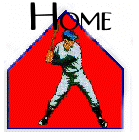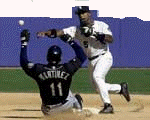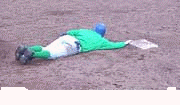|
Navigate this
The
Quoted
Learn
Apparel
Other Sites made by
|
Brookside Little League
BASERUNNING Good teams are often judged on their ability to manufacture runs. What this means is they didn't string together enough hits (or any hits for that matter) to score a run. An example would be a hitter reaching on a walk, stealing second base, going to third on a ground out hit to second, and scoring on a fly ball. In this case a run was scored without the aid of a base hit. Other skills are important in a teams ability to manufacture runs, but one thing for sure, poor baserunning will inhibit a teams ability to manufacture runs on a regular basis. Worse than that, poor baserunning will take your team out of scoring opportunities. There may be no worse feeling in baseball than being picked off a base or making a mental baserunning mistake. There is no where to hide when this happens and it can be a long walk back to the dugout. You may consider yourself a base stealing threat every time you get on base, or maybe you look for certain situations to take an extra base. Whatever your running ability, your value as a baserunner is important to your team.
KNOW THE VALUE OF YOUR RUN As a baserunner you always need to be aware of the value of your run. This is dependent on the game situation and your ability. Your strategy on the bases will be different depending on the inning and the score. Have you seen a player being picked off first base when their team is down by 4 or 5 runs? It can be the nail in the coffin for the team. It's a mental error and should never happen, but it does, even at the major league level. This next section will cover many of the fundamentals necessary to be a good baserunner.
Home to First
GETTING OUT OF THE BOX Regardless which side of the plate you hit from, your first step out of the box is a crossover step. Drive out of the box as if you were stealing a base. Get in the habit of getting out of the box quickly; this helps you at the close play at first and may just turn that long single into a double. As you take your first couple steps, pick up the ball. Assume there will be a play at first base on any ball hit on the ground or on a line. Once you know where the ball is heading, focus in on where you are going.
RUN EVERY BALL OUT! HARD! Few players in the Majors run out every ball; it doesn't matter if they hit a ground ball right back to the pitcher. However, if your goal is to play at a higher level or to lead by example, then run every ball out and run it out hard.
RUN THROUGH THE BASE Once you've determined that the ball is going to be fielded by an infielder, focus on the front part of first base. As you hit the base, start breaking down. This gives the illusion to the umpire that you were at the bag sooner than if you break-down after you pass the base. After you have crossed the base, slow down and look to your right to see if there was an errant throw.
TAKE A TURN If the ball is going to make it past the infield, get ready to round first base. Do this by moving off the line and into foul territory to set yourself up for the turn at first. Try to hit the inside corner of the bag with your left foot. Be aggressive with your turn, put pressure on the outfield to field the ball cleanly and make a good throw. There's a fine line between being aggressive and being stupid. Put yourself in position to take advantage of any mistakes but don't get caught being too far off the base.
COACHING TIP
Hustle is mandatory! As a team rule, every player must run hard on
all hit balls. Make sure there is a penalty for breaking the rule
LEADING OFF Once you have reached first base, your first priority is to look over to your third base coach for signs. There is nothing more frustrating for a coach than to try and give a sign and not have the player on base or at the plate looking at the same time. Get in the habit of looking to your coach for the sign right after each pitch. Stay on the base until you have received the signs from your coach and the pitcher has made contact with the rubber. Once the pitcher has made contact with the rubber, you can start taking your lead.
When taking your lead, remember the following:
SHUFFLE Once the pitcher has started his delivery, you want to take your secondary lead. The purpose of the secondary lead is to shorten the distance to second base and have some momentum going toward the base. To get to your secondary lead, you want to take two shuffle steps toward second base. The goal is to complete the second shuffle step as the ball crosses the plate. If the ball is hit on the ground, you just cross-over and continue to second base. If the catcher catches the ball, return to first base quickly.
ON CONTACT When the ball is hit, you quickly need to read the trajectory. If it's a ground ball, perform a cross-over and run hard to second. If the ball is hit on the line, freeze and make sure it makes it past the infield before continuing on to second.
SLIDE
Unless you're stealing second, don't slide head first into second base. The chances of being stepped on and injured are too great. For younger players, the head first slide is not recommended for anything other than diving back to first. A head first slide puts you in a vulnerable position where it is easy to injure your hands, shoulders, and head. A good bent leg slide strait into the base is the best and safest way to get to the bag, protect yourself, and break up a double play. Go to any youth baseball game and you'll see players who have scrapes all over their legs from sliding. Player's mistakenly think that a bent leg slide is performed by sliding on the side of the leg. The proper way is to slide on your butt. Practice sliding in grass and check the stains on your pants. If they are on the side of your leg, you're not sliding properly. Another common problem in sliding is putting your hand down during the slide. This is often the cause of jammed fingers, wrists, and sometimes shoulders. Get in the habit of sliding with your hands up. If you can remember to slide on your butt with your hands up, you will be sliding pain free from that point on.
LEADING OFF After you get your sign from the third base coach, make sure you act exactly the same as you do when you don't plan on stealing. Often young players get a sign from the coach and then they change things.
WHAT TO LOOK FOR Once you take your lead, your focus is solely on the pitcher. What you look for depends on whether the pitcher is a left-handed or right-handed pitcher.
HEAD A pitchers head position and movement will often tell you what he is going to do before he does it. There is nothing as specific like there is with the heels to look for. What you want to look for is patterns or a movement that gives away his intentions. It may be the 3rd or 4th inning before you discover something, but if you do you can use it to your advantage. An example would be a pitcher that always glances towards a certain location when he is going to make a move to first but focuses on a different location when he is going to the plate.
RHYTHM Some pitchers fall into a rhythm when pitching, especially if they are throwing the ball well. They want to get the ball from the catcher, get on the mound, take their stretch and throw the ball. You can often time them when you are on the bench or in the batters box. If you think you have a pitcher timed and you want to use this method to get a good jump, you may not want to take your maximum lead. You want to take an average lead to give him the impression that you are not a threat to steal.
RIGHT-HANDED PITCHER HEELS The most common focal point to watch on a right-handed pitcher is his heels. If the pitcher lifts his left heel first, he is throwing home. If he lifts his right heel first, he is throwing to first. When using this method you may find it easiest to concentrate harder on the right heel than the left. The reason is if you see movement with left leg but the right heel remains still you know he is going home. If you concentrate on the left heel you may anticipate any movement as the pitcher going to the plate. So if watching the heels is so cut and dried, why focus on anything else? The pitcher may give away where he is going to throw the ball before he lifts either heel. If you can find out something that gives away what he is going to do before he lifts a heel then you are greatly improving your chances of being able to steal second off the pitcher.
SHOULDERS This often is a good place to focus with a pitcher that comes set with an slightly open stance. He does this to get a better view of you as you take your lead. The advantage to you is the pitcher will often close his shoulder before he lifts his left heel as he goes to the plate. So, when you see the shoulder close...you're gone. If the shoulder comes toward you, then he is throwing to first.
LEFT-HANDED PITCHER LEG KICK Often a left-handed pitcher will have a higher leg kick when going home then when coming to first. This can enable you to get a great jump as you can actually start stealing as the leg moves up past the point where he normally would make a move to first. When using this as a key, make sure you don't anticipate what he will do. You will get a good jump if you simply wait for the leg to get past the position and then move.
FOOT You may be able to tell which direction the pitcher is going by looking at his foot. When going to first, the toe will be pointing down and you won't be able to see the bottom of his shoe. When going home the toe will be pointing up and you will be able to see the bottom of his shoe.
SHOULDERS The shoulders on the pitcher can also be an indicator. Some pitcher's will keep their shoulders perpendicular to you if they are throwing home. On a move to first they will rotate their upper body toward first in order to get more on the throw. You can think of them as pointing where they are throwing. If you see the right shoulder rotating toward you, get back.
CONCLUSION These are a few of the most common indicators that can be used when leading off first base. With a good left-handed pitcher it can be difficult finding a good indicator. The runner, the first base coach, and the team on the bench should all be looking for keys that the baserunner can use.
GETTING BACK TO FIRST
Copyright © 2000 Brookside Little League, Inc. All rights reserved Brookside Little League, Inc.
Thank you , for visiting Brookside's Little Legue Web Site
|








 The
term "Little League" and the Little League logo are
trademarks of Little League Baseball, Inc., Williamsport, Pa.,
extended only to local chartered leagues for purposes of
identification and publicity
The
term "Little League" and the Little League logo are
trademarks of Little League Baseball, Inc., Williamsport, Pa.,
extended only to local chartered leagues for purposes of
identification and publicity